
The Royal Hunt of the Sun is a 1964 play by Peter Shaffer that dramatizes the relation of two worlds entering in a conflict by portraying two characters: Atahuallpa Inca and Francisco Pizarro.

The Royal Hunt of the Sun is a 1964 play by Peter Shaffer that dramatizes the relation of two worlds entering in a conflict by portraying two characters: Atahuallpa Inca and Francisco Pizarro.
The Royal Hunt of the Sun was first presented at the Chichester Festival by the National Theatre and subsequently at the Old Vic in July 1964. It was directed by John Dexter and designed by Michael Annals with music composed by Marc Wilkinson and movement by Claude Chagrin.
The cast was led by Robert Stephens as Atahuallpa and Colin Blakely as Francisco Pizarro and included Oliver Cotton, Graham Crowden, Paul Curran, Michael Gambon, Edward Hardwicke, Anthony Hopkins, Derek Jacobi, Robert Lang, John McEnery, Edward Petherbridge, Louise Purnell and Christopher Timothy.
The production was a critical and commercial success. In addition to its run at the Old Vic, it played at the Queen's Theatre, London, and toured to Aberdeen, Glasgow, Stratford, Leeds, Oxford and Nottingham.
The first Broadway performance took place at the ANTA Playhouse on 26 October 1965. The production by the Theatre Guild was the same as the original London production. In the cast were Christopher Plummer as Pizarro, David Carradine as Atahualpa, John Vernon as de Soto, Robert Aberdeen as the First Inca Indian Chieftain, and George Rose as Old Martin. The lighting design by Martin Aronstein marked the first time exposed lighting was used as an integral part of the design of a Broadway production. [1] The play ran for 261 performances. [lower-alpha 1]
The play was staged as part of the fourth Adelaide Festival of Arts in 1966. [3] It was directed by John Tasker, [4] [5] designed by Wendy Dickson, with choreography by Margaret Barr. [6]
The play was filmed on location by the now defunct National General Pictures studio in 1969, with Robert Shaw as Pizarro, Christopher Plummer switching roles to play Atahualpa, Nigel Davenport as Hernando De Soto, and Leonard Whiting, in his first role after Romeo and Juliet , as Young Martin (Old Martin was omitted from the film). The screen version has been released on DVD.
The play was revived by the National at the Olivier Theatre in April 2006 in a production directed by Trevor Nunn, designed by Anthony Ward with the original music by Marc Wilkinson and choreography by Anthony Van Laast. Leading the cast were Alun Armstrong as Pizarro and Paterson Joseph as Atahualpa.
The play was performed at the Parco Theatre in March 2020 [7] in a production directed by Will Tuckett, with original score by Paul Englishby, designed by Colin Richmond, with projection design by Douglas O'Connell, and Lighting by Satoshi Sato. Leading the cast were Ken Watanabe as Pizarro and Hio Miyazawa as Atahualpa. The production was recorded and broadcast on WOWOW television Japan, June 27 2020 [8]
An opera based on the play, with music and libretto by British composer Iain Hamilton, was premièred by ENO at the London Coliseum in 1977. [9]
The play begins in Spain, where Pizarro recruits 167 men for an expedition to Peru. He is accompanied by his second-in-command Hernando de Soto, and Vincente de Valverde, a Catholic priest determined to spread the shining light of Christianity. It is narrated or commented upon by Old Martin, a jaded man in his mid-fifties. Young Martin – another character in the play – is his younger counterpart, integrated with the time-frame in which the expedition commences. At the beginning of the voyage he is obsessed with chivalry, glory and honour, but becomes increasingly disillusioned throughout, as Pizarro's crisis of faith also unravels.
The Spanish invade Peru, hungry for gold. After many weeks, they climb a mountain to reach the abode of Atahualpa, the king of Incas and also the son of the Sun god. The Spaniards massacre 3,000 Incas and take Atahualpa captive. Instead of killing him, Pizarro makes a deal with Atahualpa whereby, if he fills an entire room with objects made from gold in two months, Atahualpa will be set free and will not harm Pizarro. As the room fills up, Pizarro and Atahualpa become increasingly close. Pizarro, who suffers constant pain from an old wound, has a crisis of faith. He reveals to Martin that he used to dream of the Sun God as a child. When the room is finally filled, Pizarro asks Atahualpa to swear to leave his men unharmed, but the king refuses. The Spaniards urge Pizarro to have Atahualpa executed, and the beginnings of a mutiny against Pizarro stir. Atahualpa tells Pizarro to allow his men to kill him, because, as the son of the Sun, he will revive the morning after anybody kills him. Pizarro agrees to do this, and is inducted into the Incan religion by Atahualpa personally. Atahualpa is decreed to burn at the stake, and Pizarro has this changed to strangling (since Atahualpa's body is required intact for the rebirth to work) if Atahualpa agrees to be baptised. He does so, and is strangled. Pizarro waits until dawn with the body, but it does not re-awake, leading him to hold the body and weep while Old Martin narrates the end of the story.
The expedition is predominantly in the name of gold, religion and belief; all Incas being heathens who must be brought before God. The play critically studies these two themes throughout the discovery of Atahualpa – the Inca Sun God – and massacre of the Incas themselves.
Music is a key element to this play, more so than any other by Peter Shaffer. He wanted strange and disturbing sounds produced on primitive instruments such as saws, reed pipes, drums (tablas and bongos) and cymbals to create the aural world of 16th Century Peru. Shaffer was so impressed with Marc Wilkinson's score for The Royal Hunt of the Sun, which he has described as "perhaps the best score for a play to be written since Grieg embellished Peer Gynt ", [10] that he now considers it integral to the play. [11]
The staging is relatively simple: an upper and lower part to the stage making up the ground plan. The main attribute is the image of the sun, which presents a creative challenge for all who undertake this mammoth production. There have been numerous suns over the years, but when the play was first staged it was a large metal contraption, with huge 'petals' that opened up and outwards. Visuals are of the essence with this play, especially the lavish Inca costumes.
Although the play is performed on an open platform stage with little scenery, the film version opened it up considerably.
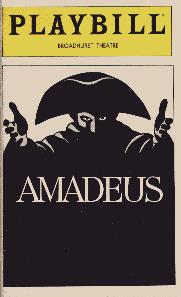
Amadeus is a play by Peter Shaffer which gives a fictional account of the lives of composers Wolfgang Amadeus Mozart and Antonio Salieri, first performed in 1979. It was inspired by Alexander Pushkin's short 1830 play Mozart and Salieri, which Nikolai Rimsky-Korsakov used in 1897 as the libretto for an opera of the same name.
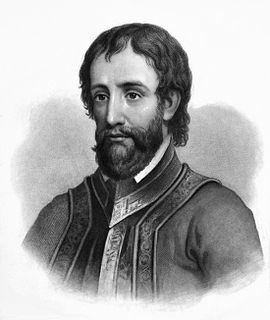
Hernando de Soto was a Spanish explorer and conquistador who was involved in expeditions in Nicaragua and the Yucatan Peninsula. He played an important role in Francisco Pizarro's conquest of the Inca Empire in Peru, but is best known for leading the first European expedition deep into the territory of the modern-day United States. He is the first European documented as having crossed the Mississippi River.

Francisco Pizarro González was a Spanish conquistador, best known for his expeditions that led to the Spanish conquest of Peru.

Pachacamac is an archaeological site 40 kilometres (25 mi) southeast of Lima, Peru in the Valley of the Lurín River. The site was first settled around A.D. 200 and was named after the "Earth Maker" creator god Pacha Kamaq. The site flourished for about 1,300 years until the Spanish invaded. Pachacamac covers about 600 hectares of land.

Sir Peter Levin Shaffer was an English playwright, screenwriter, and novelist. He wrote numerous award-winning plays, of which several were adapted into films.

Atahualpa, Atawallpa (Quechua), also Atabalica, Atahuallpa, Atabalipa was the last Inca Emperor. After defeating his brother, Atahualpa became very briefly the last Sapa Inca of the Inca Empire (Tawantinsuyu) before the Spanish conquest ended his reign.

Gonzalo Pizarro y Alonso was a Spanish conquistador and younger paternal half-brother of Francisco Pizarro, the conqueror of the Inca Empire. Bastard son of Captain Gonzalo Pizarro y Rodríguez de Aguilar (senior) (1446–1522) who as colonel of infantry served in the Italian campaigns under Gonzalo Fernández de Córdoba, and in Navarre, with some distinction, and María Alonso, from Trujillo. He was the half brother of Francisco and Hernándo Pizarro and the full brother of Juan Pizarro.

Cajamarca, also known by the Quechua name, Kashamarka, is the capital and largest city of the Cajamarca Region as well as an important cultural and commercial center in the northern Andes. It is located in the northern highlands of Peru at approximately 2,750 m (8,900 ft) above sea level in the valley of the Mashcon river. Cajamarca had an estimated population of about 226,031 inhabitants in 2015, making it the 13th largest city in Peru.
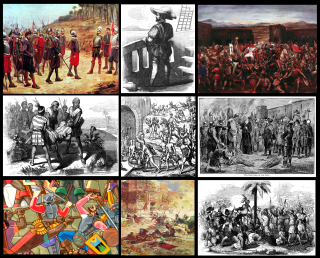
The Spanish conquest of the Inca Empire, also known as the Conquest of Peru, was one of the most important campaigns in the Spanish colonization of the Americas. After years of preliminary exploration and military skirmishes, 168 Spanish soldiers under conquistador Francisco Pizarro, his brothers, and their indigenous allies captured the Sapa Inca Atahualpa in the 1532 Battle of Cajamarca. It was the first step in a long campaign that took decades of fighting but ended in Spanish victory in 1572 and colonization of the region as the Viceroyalty of Peru. The conquest of the Inca Empire, led to spin-off campaigns into present-day Chile and Colombia, as well as expeditions towards the Amazon Basin.

The Sapa Inca was the Emperor of the Inca Empire (Tawantinsuyu), as well as ruler of the earlier Kingdom of Cuzco and the later Neo-Inca State. While the origins of the position are mythical and originate from the legendary foundation of the city of Cusco, it seems to have come into being historically around 1100 CE. Although the Inca believed the Sapa to be the son of Inti and often referred to him as Intip Churin or ‘Son of the Sun,’ the position eventually became hereditary, with son succeeding father. The principal wife of the Inca was known as the Coya or Qoya. The Sapa Inca was at the top of the social hierarchy, and played a dominant role in the political and spiritual realm.

The Ransom Room is a small building located in Cajamarca, Peru. It is considered to be the place where the Inca Empire came to an end with the capture and eventual execution of the Inca Emperor Atahualpa.
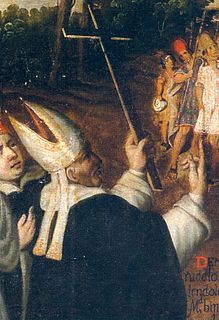
Vicente de Valverde y Alvarez de Toledo, O.P., or Vincent de Valle Viridi was a Spanish Dominican friar who was involved in the Conquest of the Americas, later becoming the Bishop of Cuzco. He became the first resident bishop in South America. He was born in Oropesa, Spain, about 1495 and most sources claim he died on Puná Island, now part of Ecuador, in 1541, at the hands of the indigenous peoples.

The Battle of Cajamarca also spelled Cajamalca was the ambush and seizure of the Inca ruler Atahualpa by a small Spanish force led by Francisco Pizarro, on November 16, 1532. The Spanish killed thousands of Atahualpa's counselors, commanders, and unarmed attendants in the great plaza of Cajamarca, and caused his armed host outside the town to flee. The capture of Atahualpa marked the opening stage of the conquest of the pre-Columbian civilization of Peru.
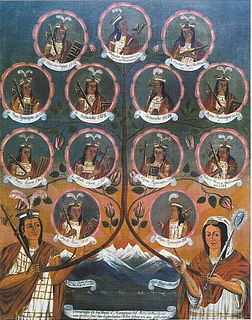
The Incas were most notable for establishing the Inca Empire in pre-Columbian America, which was centered in what is now Peru from 1438 to 1533, and represented the height of the Inca civilization. The Inca state was known as the Kingdom of Cuzco before 1438. Over the course of the Inca Empire, the Inca used conquest and peaceful assimilation to incorporate the territory of modern-day Peru, followed by a large portion of western South America, into their empire, centered on the Andean mountain range. However, shortly after the Inca Civil War, the last Sapa Inca (emperor) of the Inca Empire was captured and killed on the orders of the conquistador Francisco Pizarro, marking the beginning of Spanish rule. The remnants of the empire retreated to the remote jungles of Vilcabamba and established the small Neo-Inca State, which was conquered by the Spanish in 1572.

Francisco Xerez or Francisco de Jerez (1495–1565?) was a Spanish explorer-turned-historian, the personal secretary of conquistador Francisco Pizarro. He participated in the conquest of Peru during the first two unsuccessful expeditions led by Pizarro, Diego de Almagro and Hernando de Luque in 1524. Xerez did not stay and join The thirteen of the fame in the Isle of Gallo (1526).

The Comentarios Reales de los Incas is a book written by Inca Garcilaso de la Vega, the first published mestizo writer of colonial Andean South America. The Comentarios Reales de los Incas is considered by most to be the unquestioned masterpiece of Inca Garcilaso de la Vega, born of the first generation after the Spanish conquest.
In the Boom Boom Room is a play by David Rabe. The play follows a young go-go dancer who has a difficult relationship with her parents.
Martin Aronstein was an American lighting designer whose Broadway career spanned thirty-six years.
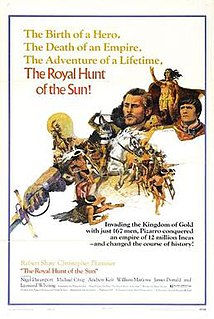
The Royal Hunt of the Sun is a 1969 British-American epic historical Drama film based on the play of the same name by Peter Shaffer. It stars Robert Shaw as Francisco Pizarro and Christopher Plummer as the Inca leader Atahualpa. Plummer appeared in stage versions of the play before appearing in the film, which was shot in Latin America and Spain. The film and play are based on the Spanish conquest of Peru by Pizarro in 1530.
Marc Wilkinson is an Australian composer and conductor best known for his film scores, including The Blood on Satan's Claw, and incidental music for the theatre, most notably for Peter Shaffer's The Royal Hunt of the Sun. His compositional approach has combined traditional techniques with elements of the avant-garde. For most of his life resident in the UK, he has now retired from composition and currently lives in France.